Quite often, many conversation topics I see at this time of year centre around ‘the season being over’. And indeed, this is true for many of Europe’s most popular leagues. Still, if you’re in a similar situation, and you or people you like spending time with have been lamenting the end of the season, perhaps this article could spark some interest.
This summer, in international football, we have the FIFA Women’s World Cup, the U21 European Championships, and the U19 European Championships — not to mention the FIFA U20 World Cup, which Uruguay won. On top of that, you can catch top-quality talent from around the world in North America, South America, Africa and Asia, with football life still ticking over in those corners of the globe.
There’s plenty of analysis on the Total Football Analysis website that’s worth checking out if any of the above peaks your interest, but those specific areas won’t be the focus of this article. Instead, we’re going to highlight Europe’s ongoing club football.
While the majority of Europe’s top leagues have finished competing for the summer, taking some time to bolster their squads to try and reach their respective goals in the 2023/24 campaign, there is still quality club football being played in the continent for lovers of the beautiful game to enjoy.
This tactical analysis will provide a brief rundown on three players we’ve enjoyed watching within their respective teams’ strategies and tactics in Europe’s summer leagues this year. Our analysis will aim to shine a light on some upcoming names from Europe’s summer leagues that deserve some recognition and could be worth a watch if you’re so inclined.
All stats and data used in this scout report have been sourced from Wyscout. Without further ado, let’s get on into the first of our five players to watch.
Emerson Deocleciano, 23 years old, RFS

The first player on our list is Emerson Deocleciano (174cm/5’9”, 69kg/152lbs) from RFS, in Latvia’s top flight, the Virsliga. Full disclosure, I initially turned my attention to the Virsliga quite recently, and it is still not a league I’d be comfortable saying I have great familiarity with.
However, with talents like Belgian Pro League side Genk’s Tolu Arokodare, Parma’s Gabriel Charpentier and Spezia’s Raimonds Krollis, who played minimal minutes in Serie A last season, among the talents to have come through Virsliga in recent seasons, it’s undoubtedly a league worth paying some attention to, especially when European club football is more limited in the summer.
Deocleciano is undoubtedly one of the standouts in the league this season. The Brazilian attacker is an excellent dribbler, direct goal threat and chance creator. The right-footer predominantly plays on the left of RFS’ 4-2-3-1 in the league this term.
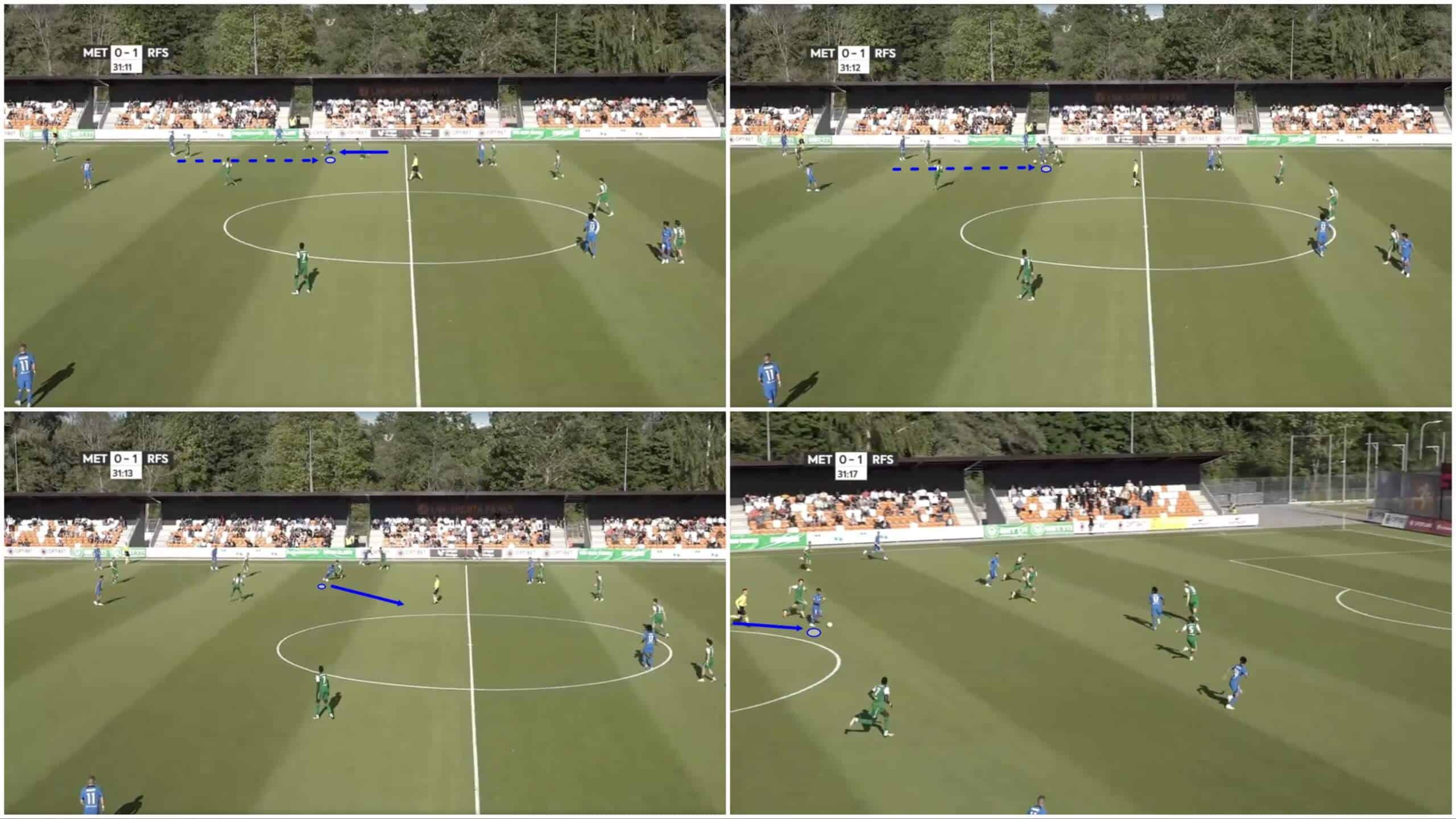
The attacker loves receiving the ball to feet with his back to the defender and drawing that defender in before swivelling away into the space behind him. That defender, suddenly accelerating, as shown in figure 2. He possesses blistering pace and is a very powerful runner with mobile hips that help him to turn on a dime when receiving the ball in situations such as the one above.
Additionally, Deocleciano has quite impressive upper body strength and balance, both of which help him to hold off defenders, withstand tackles and dribble past defenders while maintaining a good level of pace.
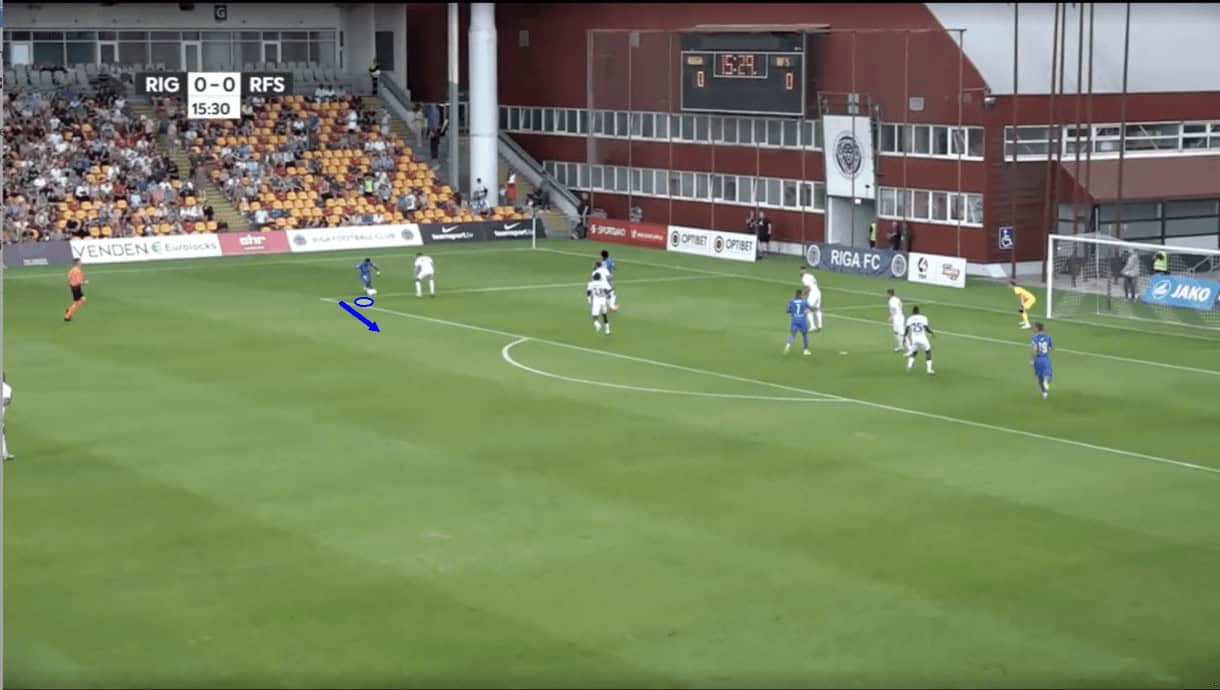
A common aspect of the RFS man’s game is to receive out wide and knock the ball inside just a bit — creating some space for himself to march forward and line up a shot from the corner of the box. He’s very good at getting the ball out of his feet in tight areas to create a shooting opportunity like this.
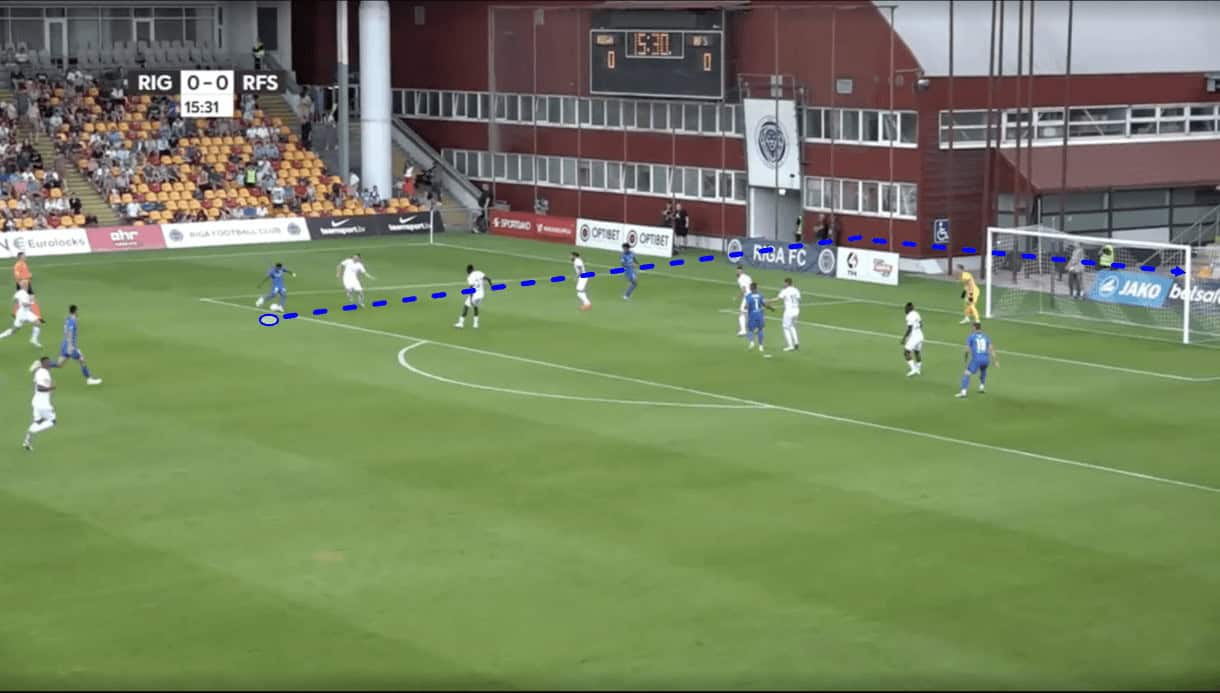
As play progresses into the following image, we see how Deocleciano created a decent shooting angle around the defender in front. He was able to bend the ball around that defender and curl the shot towards the far post, putting his team one goal ahead with a spectacular strike that shows off his powerful shooting ability and impressive technique.
The 23-year-old attacker is typically composed in front of goal, generally not wasting his shooting opportunities in good positions. When he receives the ball in the box, for instance, he makes take that touch to get the ball out of his feet and line up a nice shooting angle rather than immediately rushing into the shot, as a less composed finisher may do.
With that said, Deocleciano’s shooting isn’t perfect. He sometimes decides to unleash a shot far too early or in very unrealistic goalscoring situations. So, his decision-making in front of goal is an area of his game that definitely needs improvement.
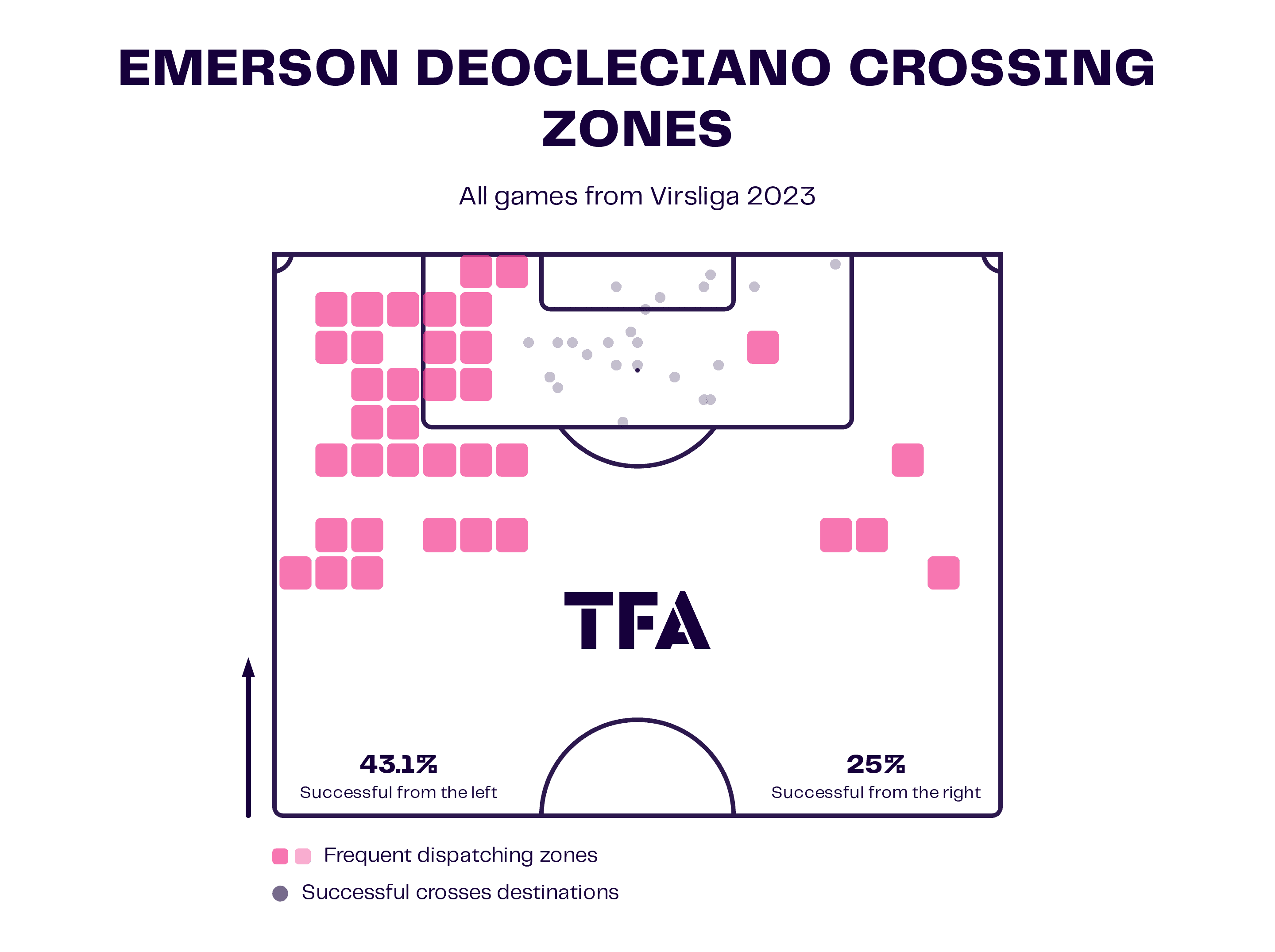
We can see the Brazilian attacker’s crossing zones for the 2023 season in figure 5 above. Like when he cuts in onto his right foot to shoot, we sometimes see the Brazilian attacker cutting into the half-space to send a cross into the box.
The wide man is good for getting his head up and quickly surveying his options before acting, even if his decisions are sometimes questionable, helping him to spot good crossing opportunities when they present themselves as he cuts in from the left.
A movement we often see him make when dribbling is to chop the ball back onto his right before taking a touch to move the ball forward and set up a crossing opportunity — this is a particular part of his game that opponents should be aware of.
Deocleciano definitely likes to cut back onto his right rather than sprint to the touchline; this is where he’s more comfortable, so it can lend a hand to the opposition when trying to defend against him in that he can be a bit predictable in that way. However, with the dribbling technique and physical traits we mentioned before, he can be a problematic attacker to stop even if the opponent knows he’ll be cutting back onto his right.
He has an average-to-low defensive contribution, but this can be improved. Furthermore, he will counterpress aggressively when the ball is played near him to try and create a quick attacking opportunity. In settled defence, though, it’s possible he could up his work rate a bit more as he doesn’t offer much value when his team is without the ball at the moment, so you sacrifice something there for what he can give you with the ball.
Deocleciano will unlikely spend much longer playing in Latvia and will surely make a move soon. It’d be interesting to see how he’d handle a jump in competition, perhaps to somewhere such as the Eredivisie or Belgian Pro League.
Tobias Fjeld Gulliksen, 19 years old, Strømsgodset
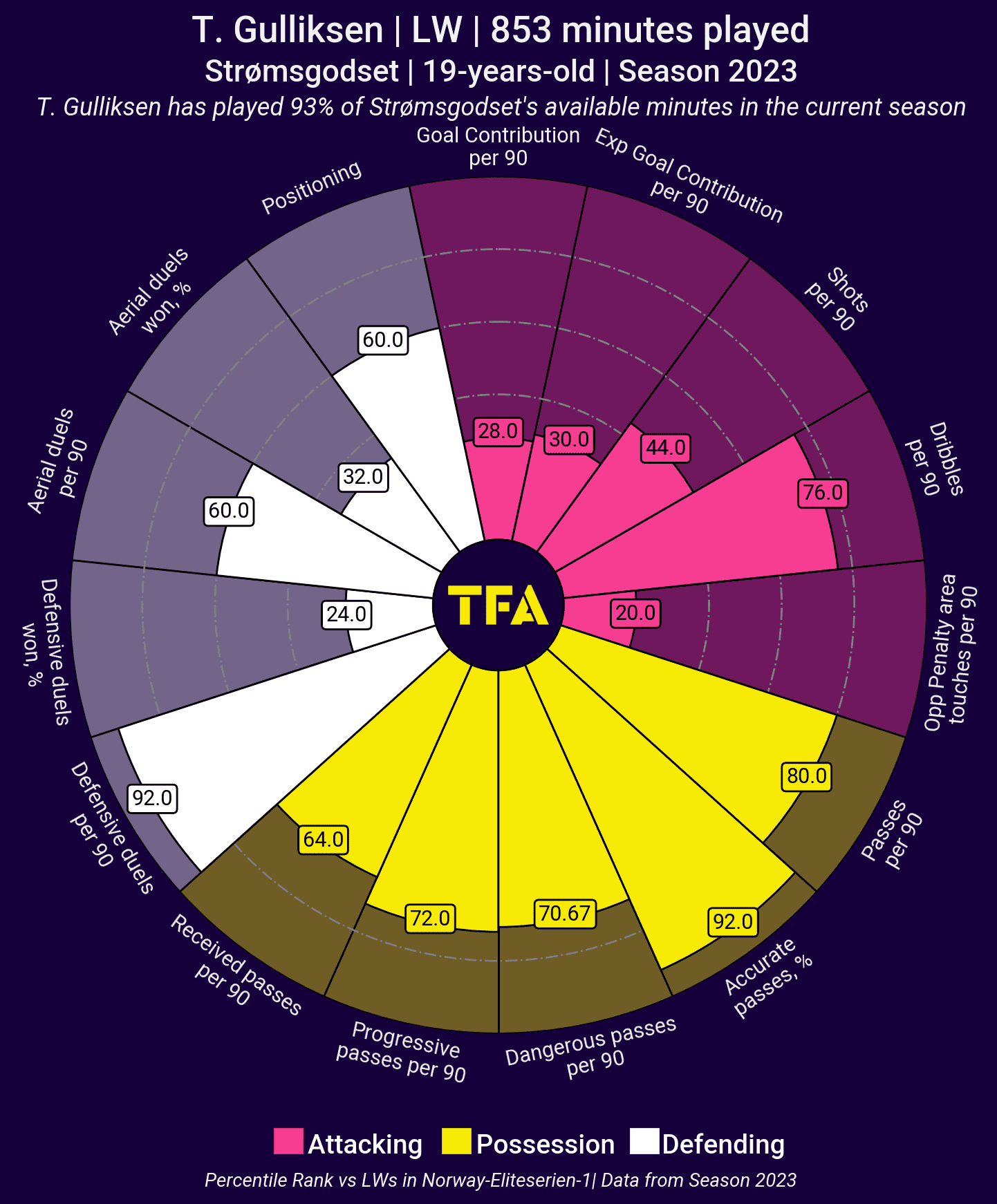
Second on our list is Strømsgodset’s left winger Tobias Fjeld Gulliksen (181cm/5’11”, 74kg/163lbs). The Norwegian winger is just 19 but has plenty of senior football experience, first appearing on Godset’s bench back in 2019, just turned 16, and making his Eliteserien debut in the 2020 campaign — very shortly before his 17th birthday. At the time of writing, he’s made 78 appearances for his club, scoring 10 goals and making six assists.
Gulliksen has only ever played for Strømsgodset, coming through the club’s youth academy. However, like Deocleciano, we can’t help but feel his future lies elsewhere — and we don’t envision that future being very far into the distance. Gulliksen could be of interest to clubs in Europe’s top-five leagues.
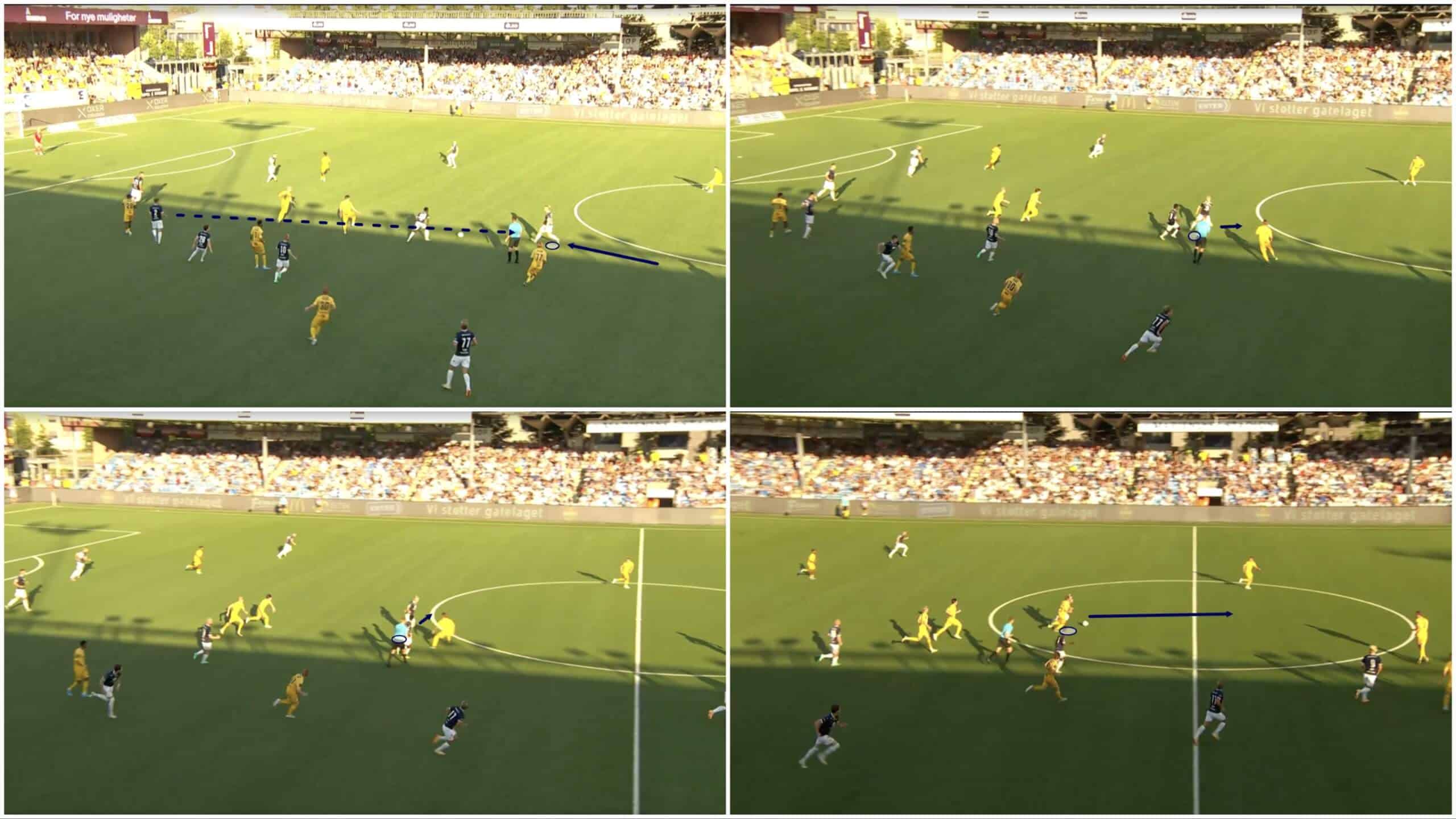
A tricky, high-volume dribbler who loves working the ball out of tight spaces, Gulliksen is comfortable receiving under pressure with his back to the defender. He’s good at drawing opposing defenders in before blasting past them with the help of his impressive balance, agility and technique — all of which he possesses in abundance.
In figure 7, we see an example of a typical element of Gulliksen’s game, which is the way in which he throws defenders off balance by slightly moving in a direction but not fully committing, leaving it open to the possibility that he’ll switch back to the other side. We see the 19-year-old performing in this manner in the top-right and bottom-left sections of figure 7.
He draws the defender in the top-right, happily biding his time before making a move. Still, he waits in the bottom-left image, waiting for the defender to slow down, slightly throwing him off-balance and then, when the time is right, accelerating away on the same side he’d been leaning to, bursting off into space beyond the defender.
At times, he will cut back to the other side, but we often see Gulliksen bait the defender with the idea that he could exit on the other side, forcing them square or throwing them off-balance before sprinting off into space. This movement also gives the Norwegian winger time to observe the pitch around him and make a more informed decision about his subsequent actions, which allows him to act fast when the time to be decisive comes.
On top of his dribbling ability, Gulliksen can produce line-breaking passes from the left wing and left half-space for runners moving in behind. The winger likes to carry the ball far upfield into advanced areas from where he can cut it back for a striker in the danger zone. He’s not a very frequent shooter and is undoubtedly more of a creator.
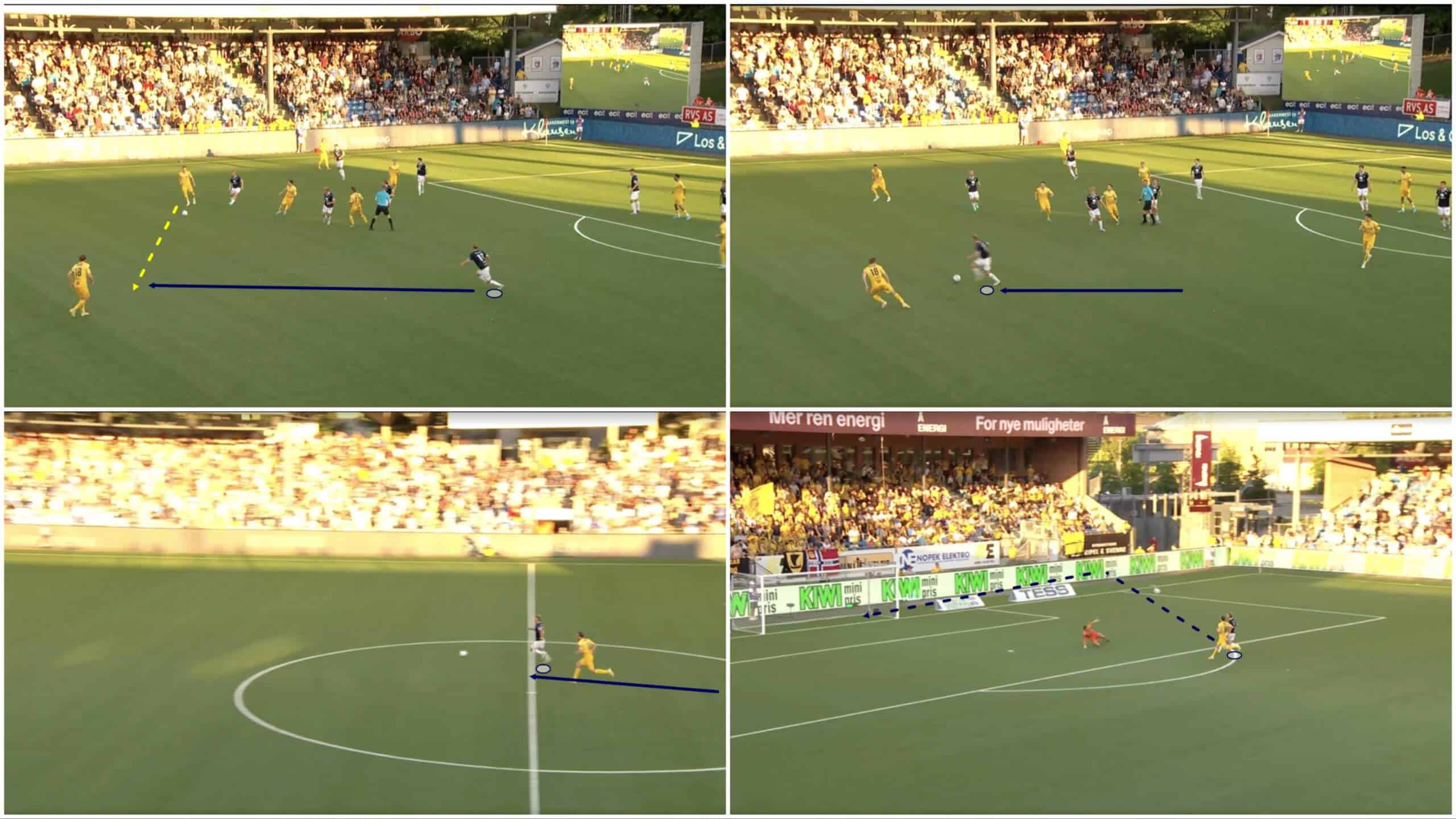
Gulliksen represents a lethal counterattacking threat due to his pace and ability to carry the ball forward quickly without sacrificing a tonne of control over the ball. Furthermore, as his 92nd percentile rank in defensive duels per 90 and 60th percentile rank in defensive positioning would suggest, he’s a player who provides a great deal when his team is without the ball and adds a lot to his side’s defensive game.
Now, he’s not playing for a team that presses very high. Godset’s 12.06 PPDA for 2023 ranks fourth-highest among Eliteserien sides, while their 42.2% possession is the second-lowest ranking of all teams in Norway’s top flight this season. As a result, his defensive contribution doesn’t show in terms of high regains, even if he’s evidently got the technical and physical ability to contribute in that area from observing his game.
However, we see his defensive contribution in his interceptions and deeper regains, which help his team present a severe threat on the counter.
Figure 8 above provides an example of the Godset winger anticipating a pass excellently and sprinting into position to win the ball for his side before blasting past the intended receiver, leaving him with little chance of stopping the teenage attacker from progressing into a 1v1 with their goalkeeper.
With Strømsgodset not being one of Eliteserien’s strongest sides, Gulliksen has demonstrated an excellent ability to be a key figure in a side that needs to fight for their points and put in the hard yards every week for multiple seasons — and he’s still not even 20. It’s definitely worth catching a Godset game to cast your eye over this future star, who could be lining up alongside Manchester City’s Erling Haaland and Arsenal’s Martin Ødegaard for his national team before long.
Alexander Jensen, 21 years old, Brommapojkarna
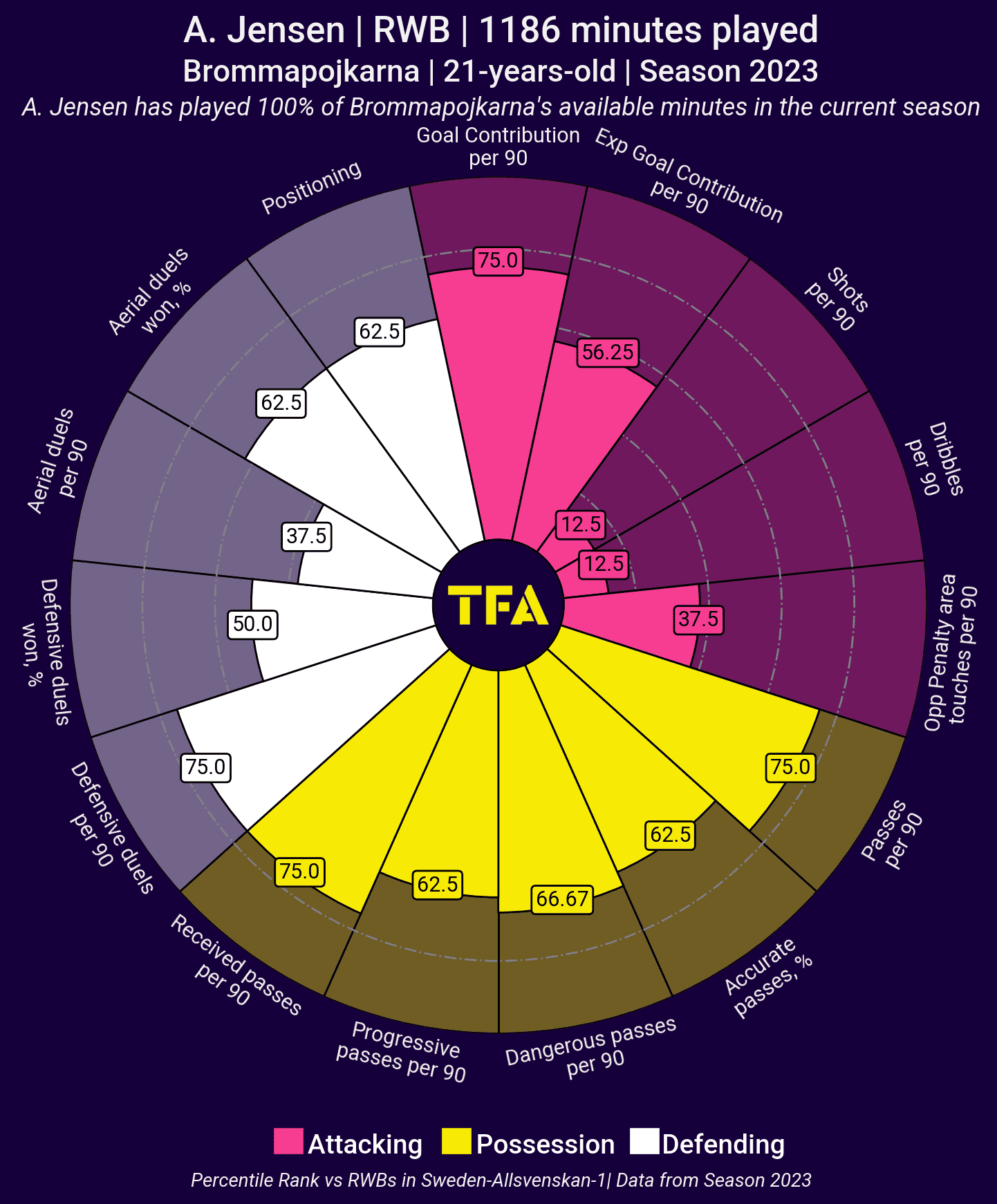
The third and final player we’re going to shine a light on today is Danish right-back/right wing-back Alexander Jensen (180cm/5’10, 72kg/158lbs) of Brommapojkarna, who are doing quite well, occupying eighth place in Sweden’s Allsvenskan on their return to the top flight for the first time since 2018.
Jensen was signed by the Bromma club back in January from Danish second-tier side Fredericia. The 21-year-old has stood out as a valuable creator, ball progressor and reliable defender in Sweden’s top flight this term, adapting to the step up in level without issue, as illustrated by the percentile rankings in the pizza chart above, as well as the fact that the full-back has played 100% of Brommapojkarna’s league minutes this term.
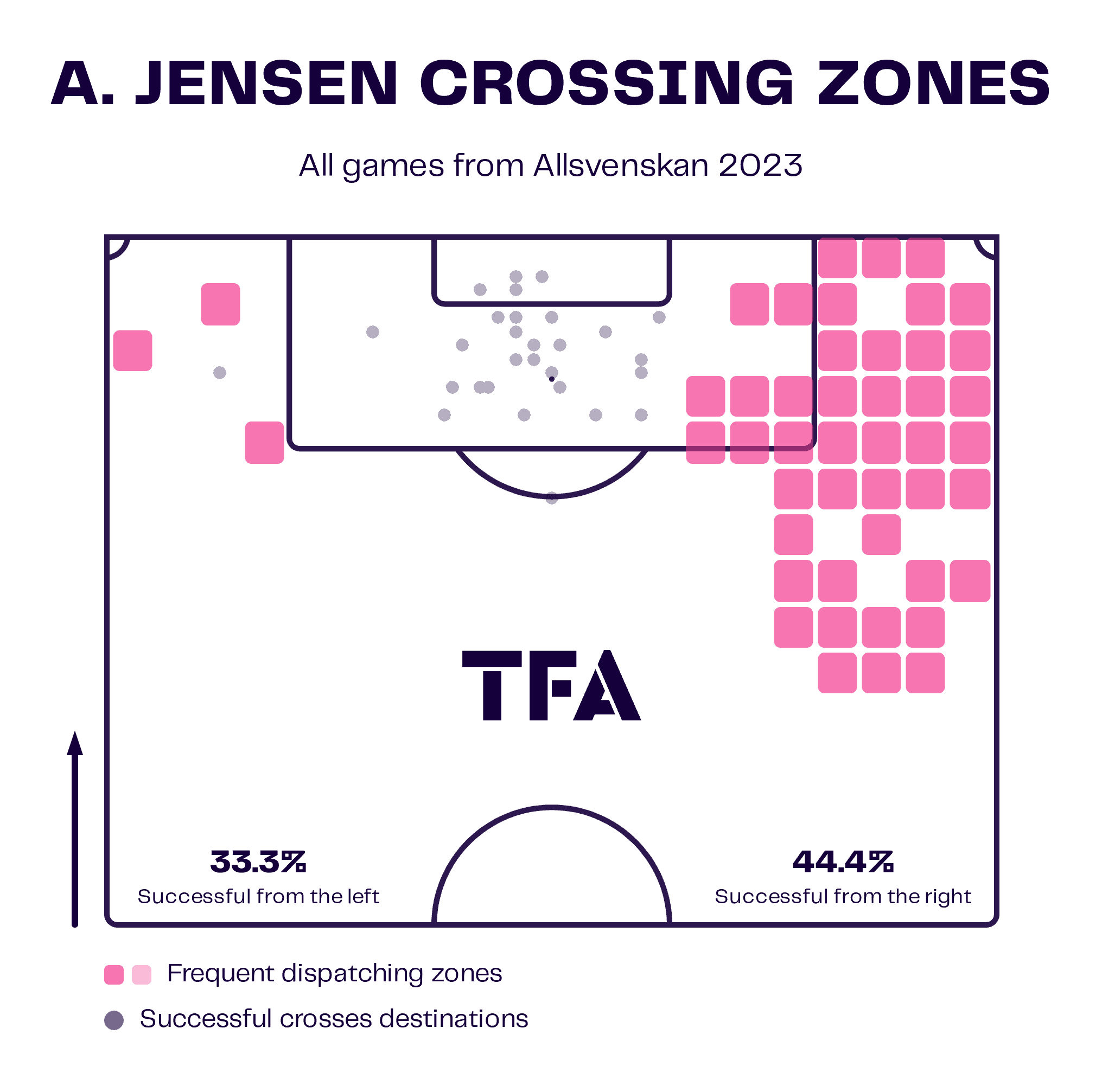
The big area we see Jensen’s chance creation come from is crossing. The visual above in figure 10 highlights the Danish full-back’s main crossing zones in 2023. He primarily puts the ball into the danger zone from wide areas. Still, some of his crosses also come from slightly more central positions, with Jensen having enough time and space to send the ball into the box for an attacker to meet in the right half-space quite commonly as well.
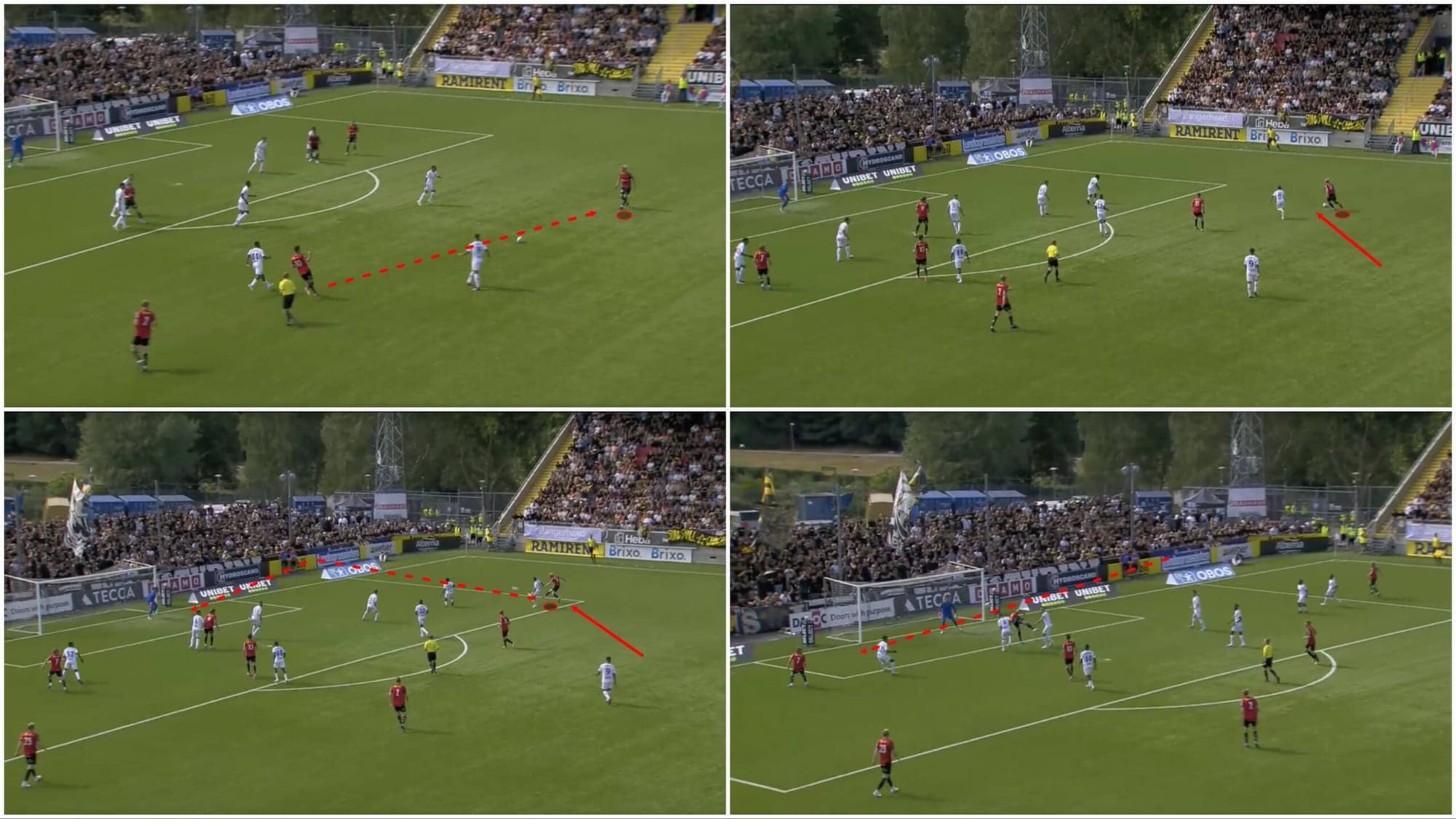
This is partly a result of his role within legendary Sweden defender and now-Brommapojkarna manager Olof Mellberg’s system, which sees the full-back sit relatively narrow when the ball is on the opposite side of the pitch, allowing Jensen to act as an option for a safe, short switch to the opposite side of the pitch.
While many full-backs will be positioned wide to receive the switch of play via a long ball, Mellberg prefers his full-backs to position themselves more centrally and receive safe short passes, ensuring the team keeps the opposition penned in with no escape from the pressure they’re building with the ball.
After receiving, the full-back must decide on the best course of action: pass to someone else and keep the attack moving, move to the half-space and cross from there or aim to progress down the wing and cross from wide.
Most often, we see the latter. With the full-back positioned centrally, plenty of space can be exploited out wide. Still, it’s also not irregular to see Jensen play the ball in early, potentially trying to catch the opposition off-guard from the half-space.
In figure 11, we see the full-back carry it to the edge of the box from the centre and send a ball in, which narrowly misses the striker’s head. This showcases the full-back’s impressive crossing ability and demonstrates why he’s a good choice for this role in Mellberg’s side.
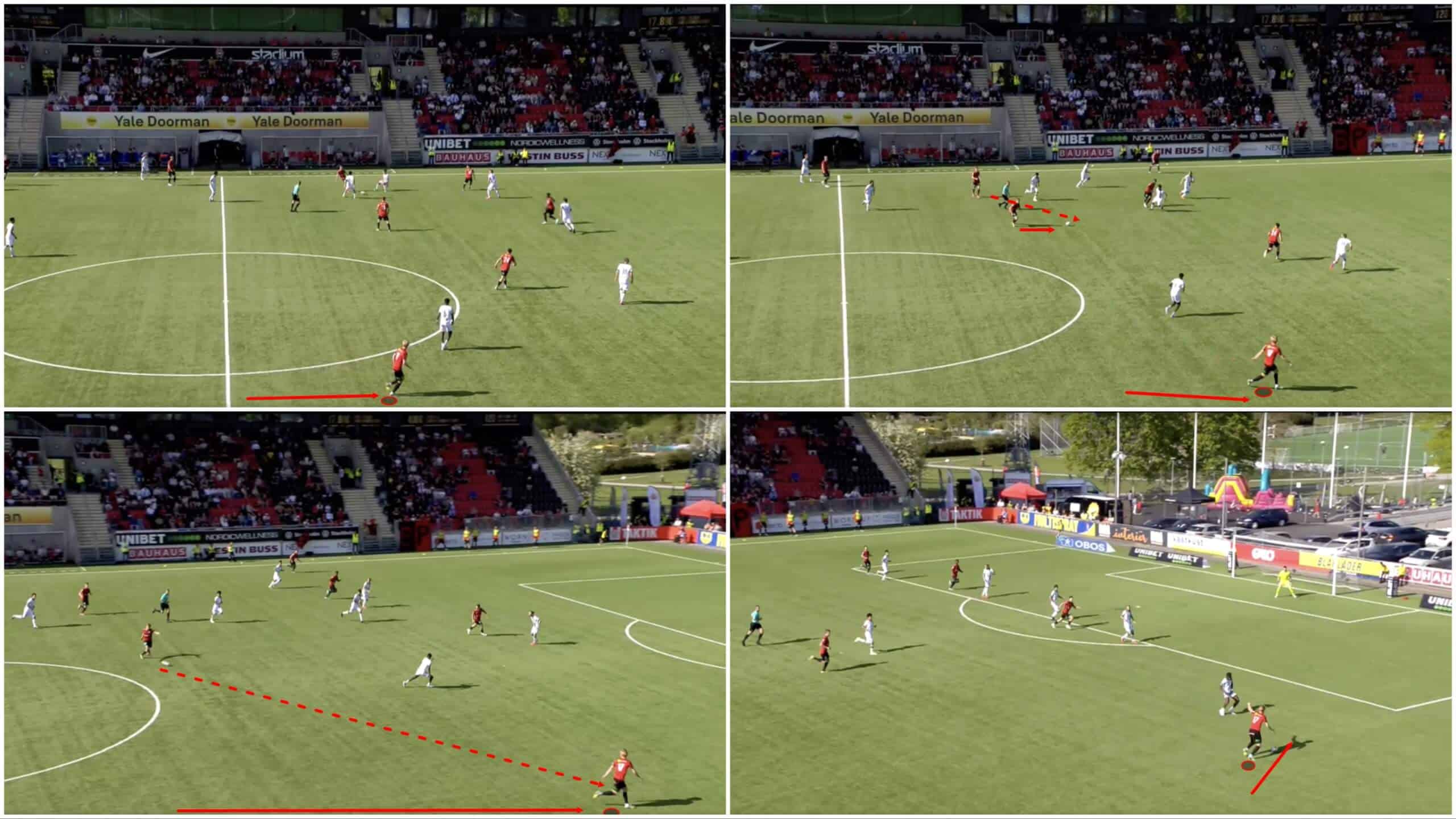
Jensen isn’t a volume dribbler and isn’t someone you’re likely to see weaving through defenders. You’re more likely to see him charging down the wing into space — the player’s off-the-ball movement is one of his most notable traits.
Here, we initially see him occupying that central position with the ball on the opposite wing again. However, as his teammates start making their way across the pitch, he begins moving out into a wider position on the nearest defender’s blindside.
By the time the ball is played to Jensen, he’s got time and space to get his head up and make a decision. While he looks like he’s lining up a cross from the half-space in the bottom-right image, he actually chose to carry on dribbling, aiming to beat his man, which didn’t work out. However, the off-the-ball movement leading up to his reception was exquisite and an excellent help for his team in breaking into the final third.
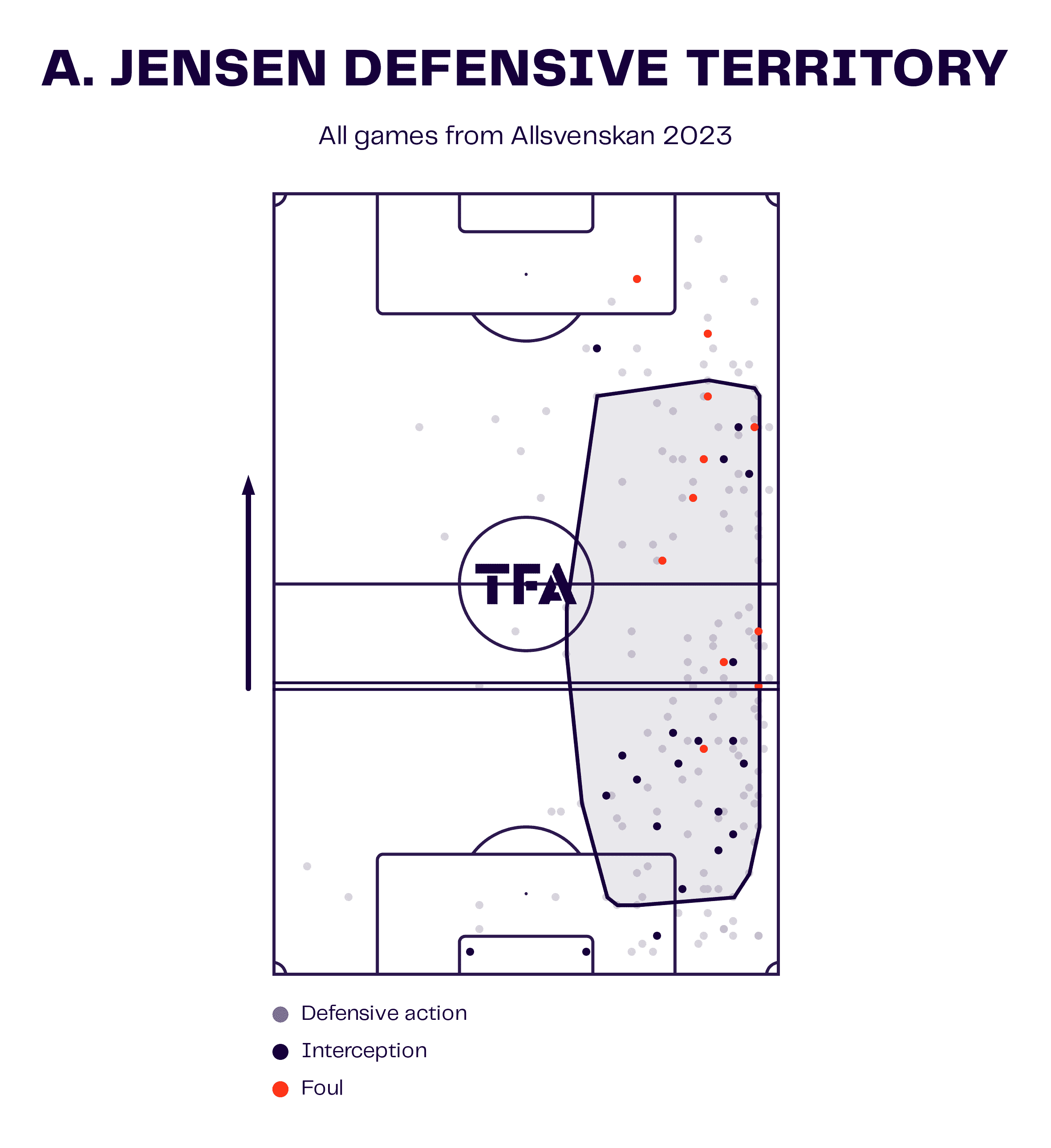
Defensively, the 21-year-old has shown plenty of comfort when defending aggressively and high upfield but is typically required to hold off on the aggressive pressure until the opposition progress into his team’s half, as the defensive territory map indicates. Still, we see a fair deal of defensive actions in the opposition’s half too. In these cases, Jensen quickly closes down and leaves his mark when the team is pressing high and closes the space quite efficiently.
The former Fredericia man has been quite reliable in defensive situations for his new team this term, with his anticipation to make interceptions standing out in particular.
Jensen has only played in Allsvenskan for a few months but has risen to the challenge fantastically, taking the raised standards in his stride. We’ll likely see Jensen spend a few seasons at this level. Still, if he sustains the levels of performance he’s shown so far and manages to build on them in the future, it won’t be a surprise to see him advance another step on the ladder by his prime years, so this full-back is undoubtedly an interesting one to watch.
Conclusion
To conclude this tactical analysis and scout report, we hope our analysis has given you some players to consider checking out at a time when many of the most popular leagues, especially those in Europe, are in the off-season.
We certainly feel these players are plenty of reason to watch their games if you’re searching for a football fix — all three may have exciting futures ahead of them!





Comments